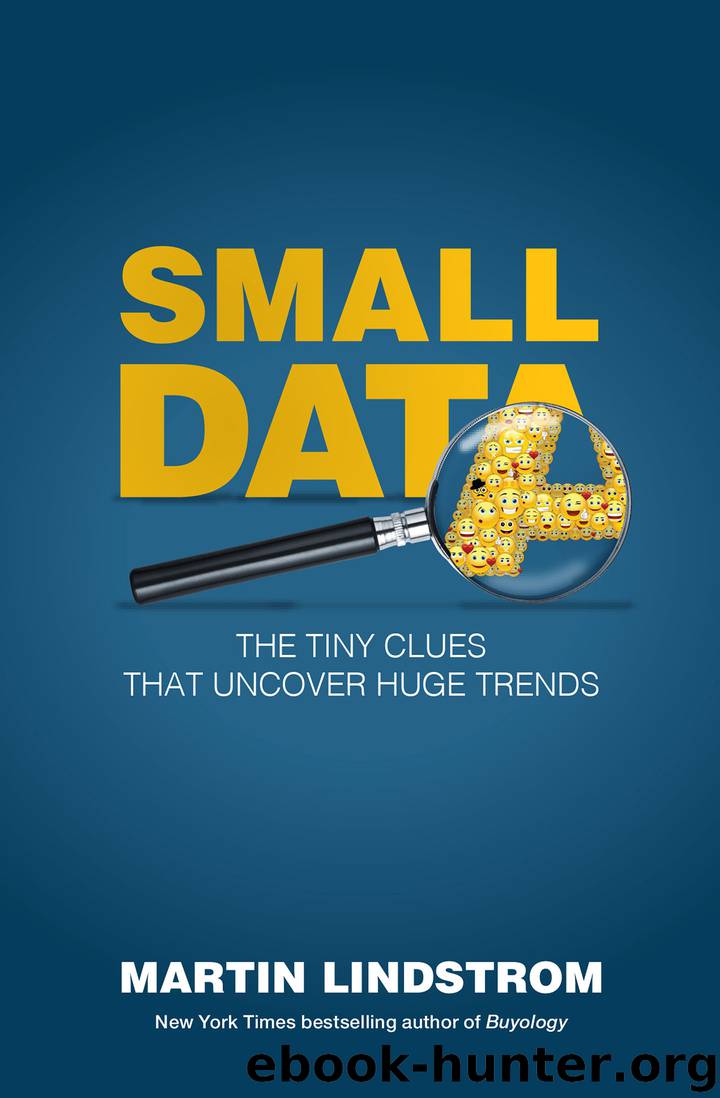Small Data by Martin Lindstrom

Author:Martin Lindstrom
Language: eng
Format: epub
Publisher: St. Martin's Press
Published: 2016-01-07T16:00:00+00:00
Chapter 6
The Case of the Missing Hand Cream
How Selfies Smoothed the Way for an In-Store Fashion Revolution
As far as products and brands are concerned, the world is no longer local. Two or three decades ago, tourists could come back from visiting a country 3,000 miles away assured that the souvenirs they’d brought home with them in their suitcases—the Sumatra-Indonesian Barbie Doll, the wooden salad tongs from Botswana with animal carvings, a sweater from French Gap with a neck zipper—were not only one-of-a-kind, but could be someday directly linked back to memory and experience. Today, there are few objects that tourists can store in their suitcases that aren’t already available somewhere, from someone, online, detaching the treasures we find while traveling from the context of experience.
Still, just as there’s a wide array of Western brands and companies that Russian and Asian consumers would be surprised to discover exist, some stores and brands remain unknown to a majority of Westerners. I’ve already mentioned Picard, France’s frozen-food chain, but it’s also safe to assume most US and European natives have never heard of Mr. Bigg’s, a Nigerian fast-food chain with over 170 locations across that country serving local delicacies including moin moin and ofada rice. What about NTT DOCOMO—not AT&T, or Verizon—which controls approximately one-half of Japan’s wireless market? Won Hundred is an up-and-coming Danish menswear company, and a Chinese eyewear chain with the breathtaking name of Helen Keller sells frames and sunglasses at 80 Chinese locations.
It’s also fair to say that few people outside of Europe are familiar with Tally Weijl, a leading Swiss-French fashion label headquartered in Basel, Switzerland, whose logo is the silhouette of an extremely pink rabbit.
Tally, as its tween and teenaged female clientele calls it, has approximately 1,000 stores in 30 countries including Ireland, Italy, Holland, Poland, Germany, Greece and Russia. Similar to H&M or Forever 21, Tally’s low prices are similar to Target’s price points. So why did Tally Weijl need to bring in a branding consultant? The chain had a problem—namely unused, unsold merchandise. For years Tally had succeeded again and again in hitting the fashion nerve—the perfect length, the trendiest style, the hottest color—but the company’s warehouses still overflowed with millions of dollars’ worth of unsold inventory. Nor did the teenaged girls I interviewed in my preliminary Subtext Research seem to enjoy visiting Tally’s physical stores. The spaces were dense, cramped and disordered, they told me, and overloud techno music pounded from overhead speakers, as if the fashion and jackhammer industries had merged beneath one roof. It was sensory overload, and not in an exhilarating way.
Why were twenty-first-century adolescent girls so fickle about fashion? Was it a worldwide problem, one caused by customers of all ages reluctant to pay full price for clothes they knew they could buy online instead at a discount? If the Internet had transformed the role of the bricks-and-mortar retailer and the definition of “social”—which it clearly has—were there any new ways of successfully combining the offline and online
Download
This site does not store any files on its server. We only index and link to content provided by other sites. Please contact the content providers to delete copyright contents if any and email us, we'll remove relevant links or contents immediately.
| Direct | Global |
| Industrial | Multilevel |
| Product Management | Research |
| Telemarketing | Web Marketing |
Influence: The Psychology of Persuasion by Robert B. Cialdini(4222)
The Miracle Morning by Hal Elrod(3963)
The Hacking of the American Mind by Robert H. Lustig(3628)
Pre-Suasion: A Revolutionary Way to Influence and Persuade by Robert Cialdini(3479)
Unlabel: Selling You Without Selling Out by Marc Ecko(3024)
Hidden Persuasion: 33 psychological influence techniques in advertising by Marc Andrews & Matthijs van Leeuwen & Rick van Baaren(2837)
Who Can You Trust? by Rachel Botsman(2753)
Ogilvy on Advertising by David Ogilvy(2742)
Kick Ass in College: Highest Rated "How to Study in College" Book | 77 Ninja Study Skills Tips and Career Strategies | Motivational for College Students: A Guerrilla Guide to College Success by Fox Gunnar(2739)
Purple Cow by Seth Godin(2735)
I Live in the Future & Here's How It Works by Nick Bilton(2558)
This Is Marketing by Seth Godin(2522)
The Marketing Plan Handbook: Develop Big-Picture Marketing Plans for Pennies on the Dollar by Robert W. Bly(2447)
The Power of Broke by Daymond John(2415)
Building a StoryBrand by Donald Miller(2400)
The 46 Rules of Genius: An Innovator's Guide to Creativity (Voices That Matter) by Marty Neumeier(2343)
Draw to Win: A Crash Course on How to Lead, Sell, and Innovate With Your Visual Mind by Dan Roam(2308)
The Tipping Point by Malcolm Gladwell(2232)
Market Wizards by Jack D. Schwager(2202)
